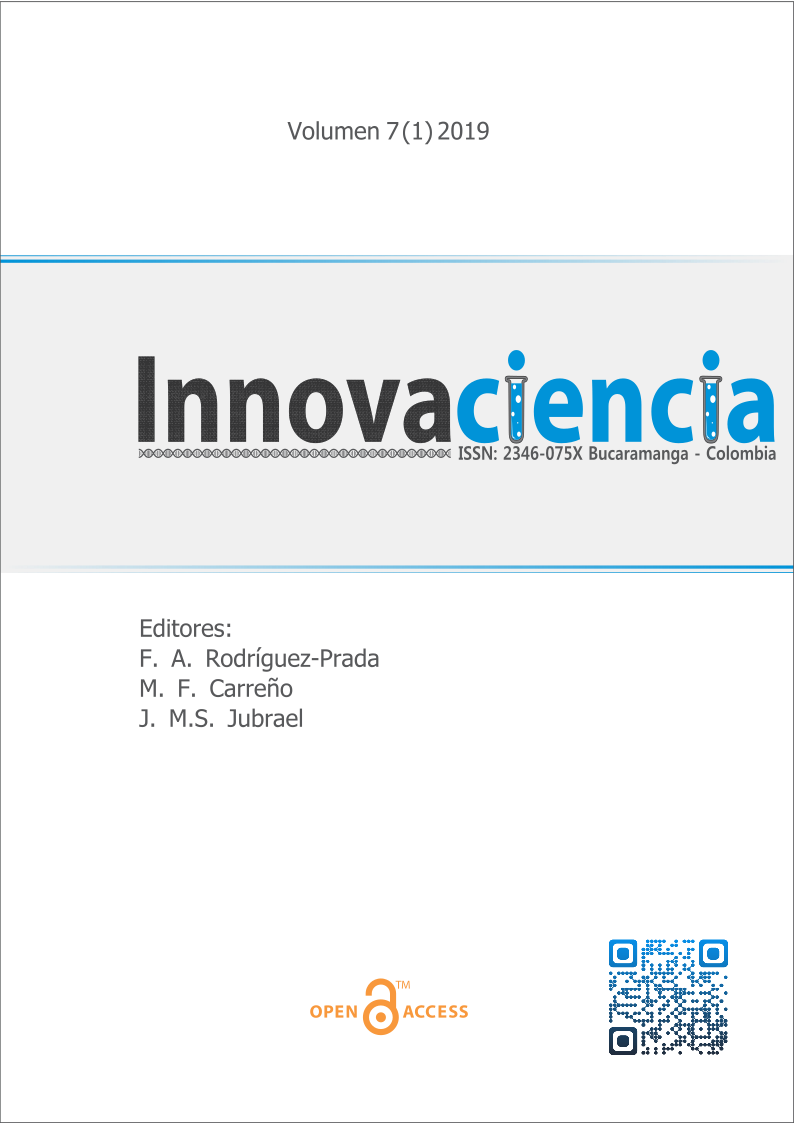Síntesis, identificación y estudio térmico de algunos nuevos polímeros inorgánicos basados en ligandos de bisditiocarbamato con silicona, teluro y algunos metales de transición
DOI:
https://doi.org/10.15649/2346075X.507Palabras clave:
bis-Dithiocarbamate ligands; Epoxy resins; Si; Te; Inorganic polymerResumen
Introduction: In recent years, there has been considerable interest in dithiocarbamate complexes because of its diverse biological roles, very few reports have been made on polymeric bis- dithiocarbamate compounds with carbon chain of n-propyl or hexamethelene with transition metals in addition of the absence of any report of organosilicone or tellurium halides with such compounds Our interest in this report based on the preparation of new series of polymers with an expected activity as a fungi side compounds followed by the using of prepared amino compound as a hardners for epoxy paints Materials and Methods: A new polymers of the general structures –(MS2CNH(CH2)6NHCS2M-)n where [M= Cu, Cd, Mn and Zn] and –(M(R)2S2CNH(CH2)nNHCS2MR2-)m where [M= Si,
R=CH 3 , n= 2 ,3 and 6 ; M=Te , R= Br , n= 2 ,3 and 6 ; M=Co, Ni R=Cl ; n= 6] have been prepared by reaction of MX2 where M= Ni ,Co, Cd , Mn
or Zn , X= Cl ; M=Cu , X= SO4 , and dimethyl dichloro silane, tellurium tetrabromide with the corresponding sodium salts of bis-dithiocarbamate
ligands. Results and Discussion: Dimethyldichloro silane is a very sensitive material to O-H group, in addition to that, TeBr4 decomposed rapidly
in water so, a series solvents may be useful with such sensitive chemicals to water , in the other hand, dithiocarbamate ligands which is usually prepared in aqueous and alcoholic solution , must be prepared and isolated carefully to apply the other steps of synthesis using a chloroform solution as a solvent. It seems for the first view for dithiocarbamato ligands it may act as a bi dentate ligands using two sulphur donating atoms that is clearly appeared in common complexes such as diethyl dithiocarbamato or pipyridyl, morpholino dithiocarbamato with representation metal elements, even in such type of elements a sulfur bridges may formed. In this study, it showed clearly that Zinc and Cadimium polymers are diamagnetic polymers that is mean that these polymers are with oxidation state equal to (II) and a tetrahedral configuration Conclusions: The study showed that the new silicone polymers act as a stable polymers compared with others. All new polymers are of a high stability with large values of char contain with commercial epoxy. Among silicone polymers, the polymer
with carbon chain equal to 3 is more stable than that with 2 carbon atoms while the silicone polymer with 6 carbon atoms is the less stable one, may thermal treatment caused decomposition combined.
Referencias
- Ning T, Xinmin G, Hailiane Z and Minyu T , Pollyhedron , 1990; 9 : 859-862. https://doi.org/10.1016/S0277-5387(00)81352-2
- Baroncini E. A, Yadav S. K., Palmese G. R, Stanzione J. F. REVIEW J. APPL. POLYM. SCI. 2016; 44103: 1 - 19
- Ahmed MAK., McWinnie W R and Granger P., Polyhedron 1986;5:859-862. https://doi.org/10.1016/S0277-5387(00)84448-4
- Huang Z, Lakshmikantham M V , Lyon M, Cava M P, J. Org. Chem., 2000;65: 3413. https://doi.org/10.1021/jo0001030
- Edward R.T, Zukerman J, Coor. Chem. Rev. 2010; 46: 254.
- Al-Rubaie A Z and Al-Luaibi M Y, Int.J. Sci. 2005; 14: 71-78.
- Müller F, Ackermann P, Margot P "Fungicides, Agricultural, Individual Fungicides". Weinheim: Wiley-VCH. doi:10.1002/14356007, 2012; 2. https://doi.org/10.1002/14356007
- Shreve O D, Anal. Chem., 1952; 24 (11): 1692-1699. https://doi.org/10.1021/ac60071a003
- Rosu D, Mustata F. . Cascaval CN, Thermochimica Acta ,2001;370(1-2):105-110. https://doi.org/10.1016/S0040-6031(00)00787-5

Descargas
Publicado
Cómo citar
Descargas
Número
Sección
Licencia
Todos los artículos publicados en esta revista científica están protegidos por los derechos de autor. Los autores retienen los derechos de autor y conceden a la revista el derecho de primera publicación con el trabajo simultáneamente licenciado bajo una Licencia Creative Commons Atribución-NoComercial 4.0 Internacional (CC BY-NC 4.0) que permite compartir el trabajo con reconocimiento de autoría y sin fines comerciales.
Los lectores pueden copiar y distribuir el material de este número de la revista para fines no comerciales en cualquier medio, siempre que se cite el trabajo original y se den crédito a los autores y a la revista.
Cualquier uso comercial del material de esta revista está estrictamente prohibido sin el permiso por escrito del titular de los derechos de autor.
Para obtener más información sobre los derechos de autor de la revista y las políticas de acceso abierto, por favor visite nuestro sitio web.















